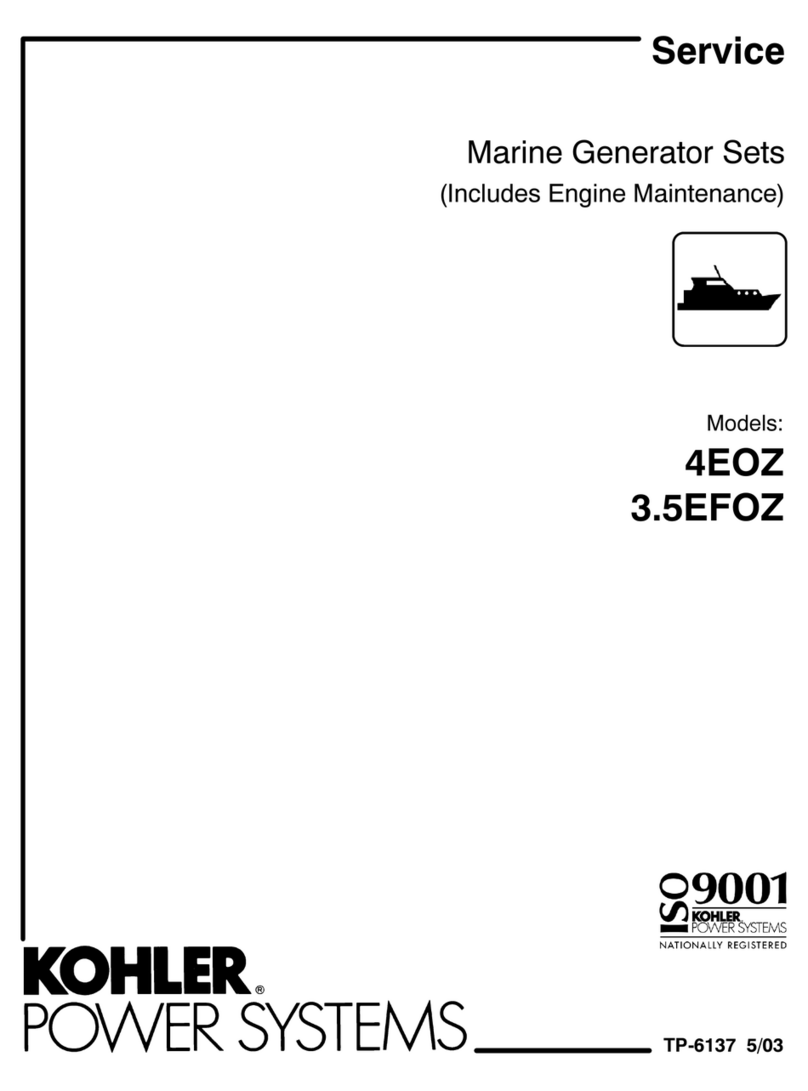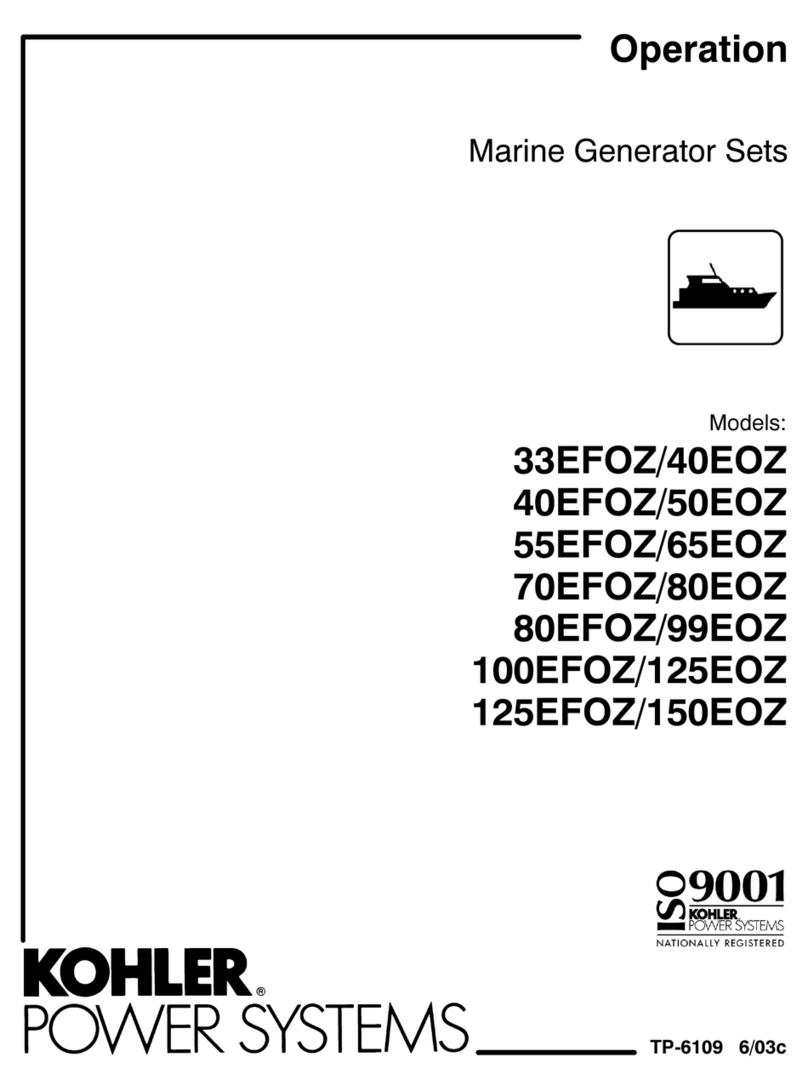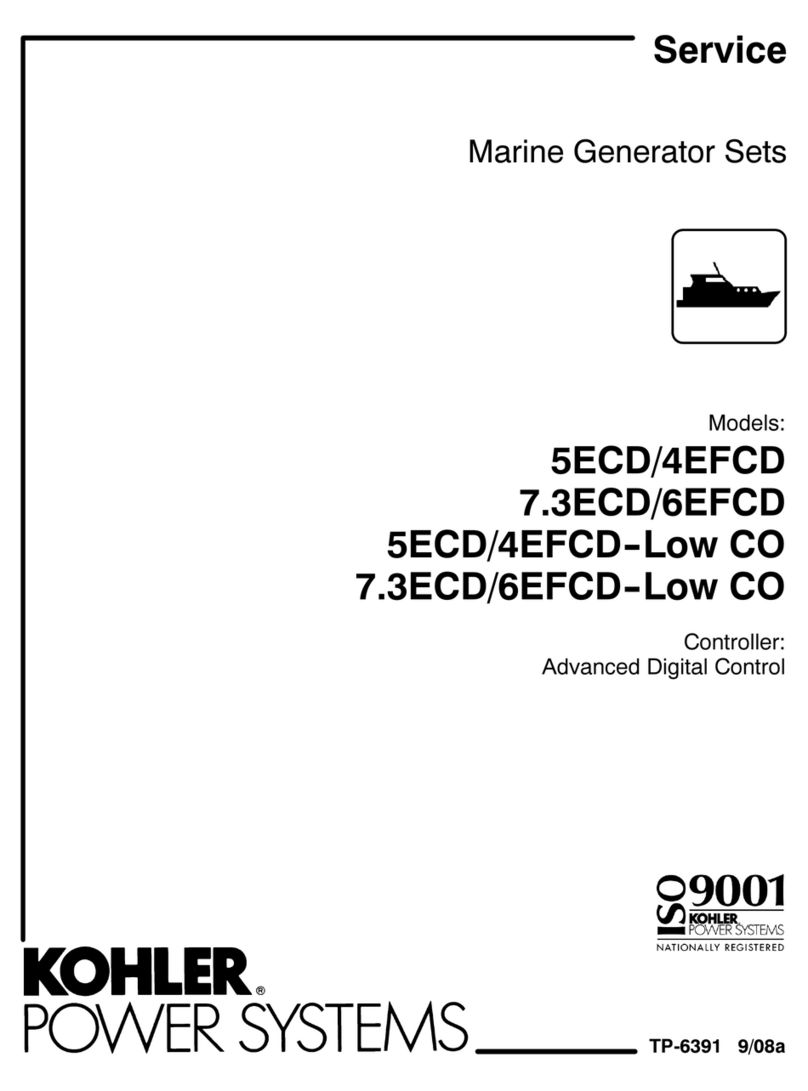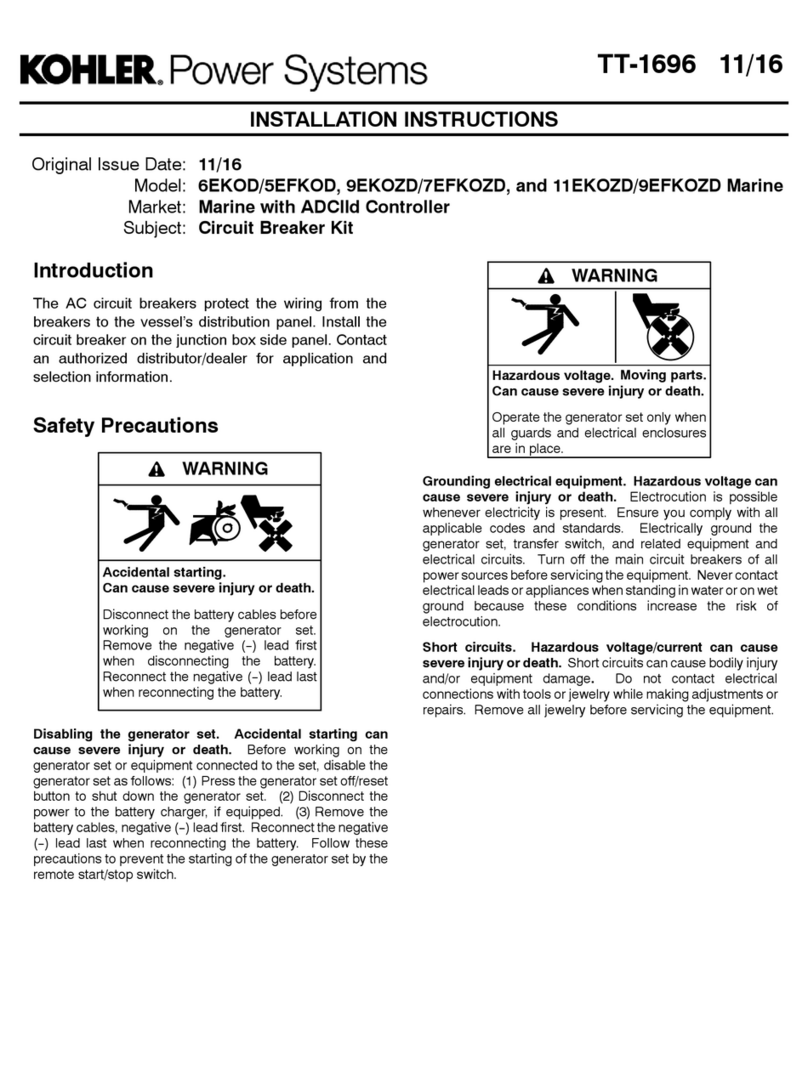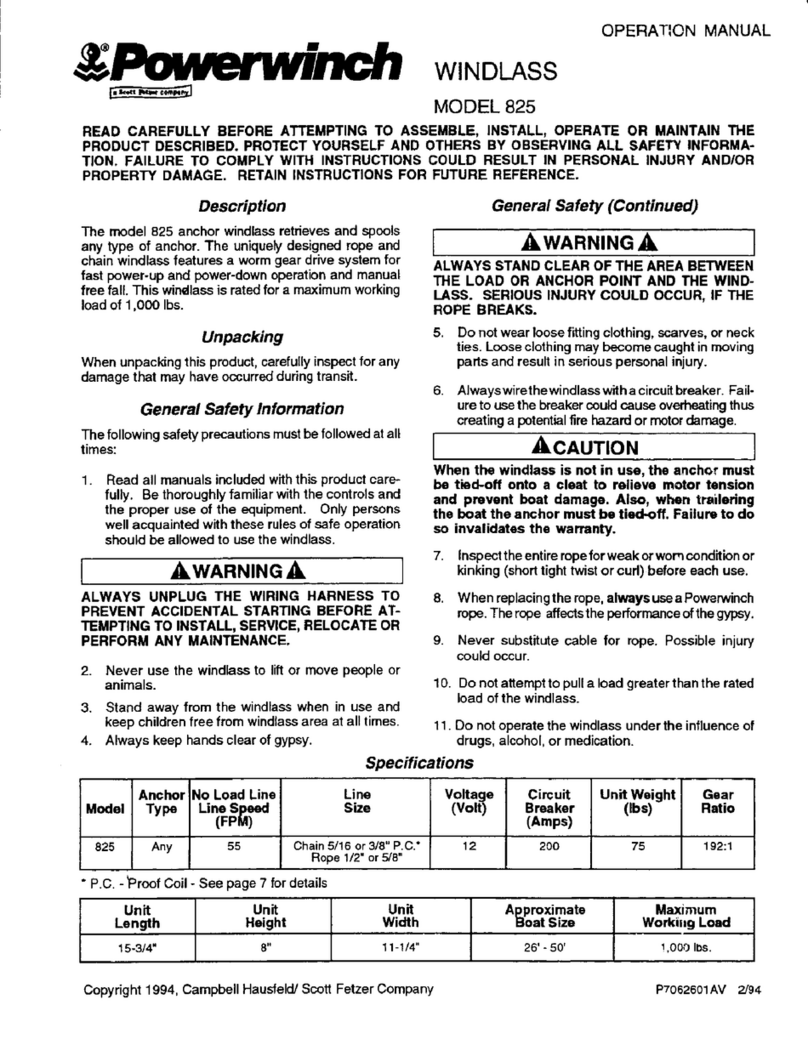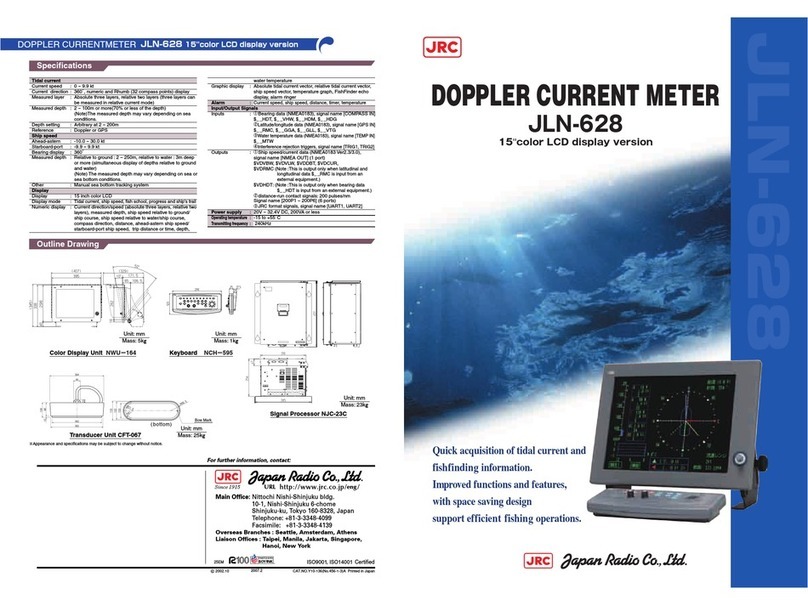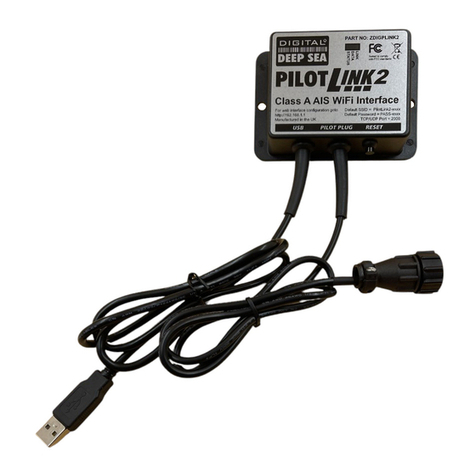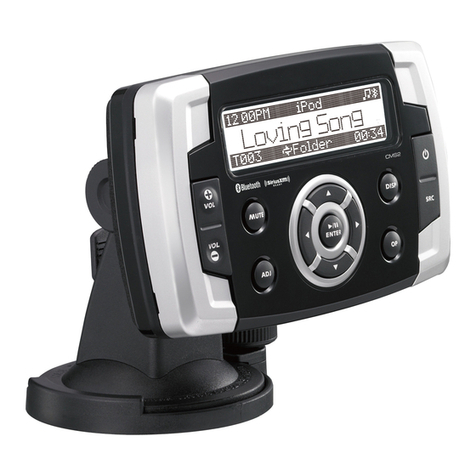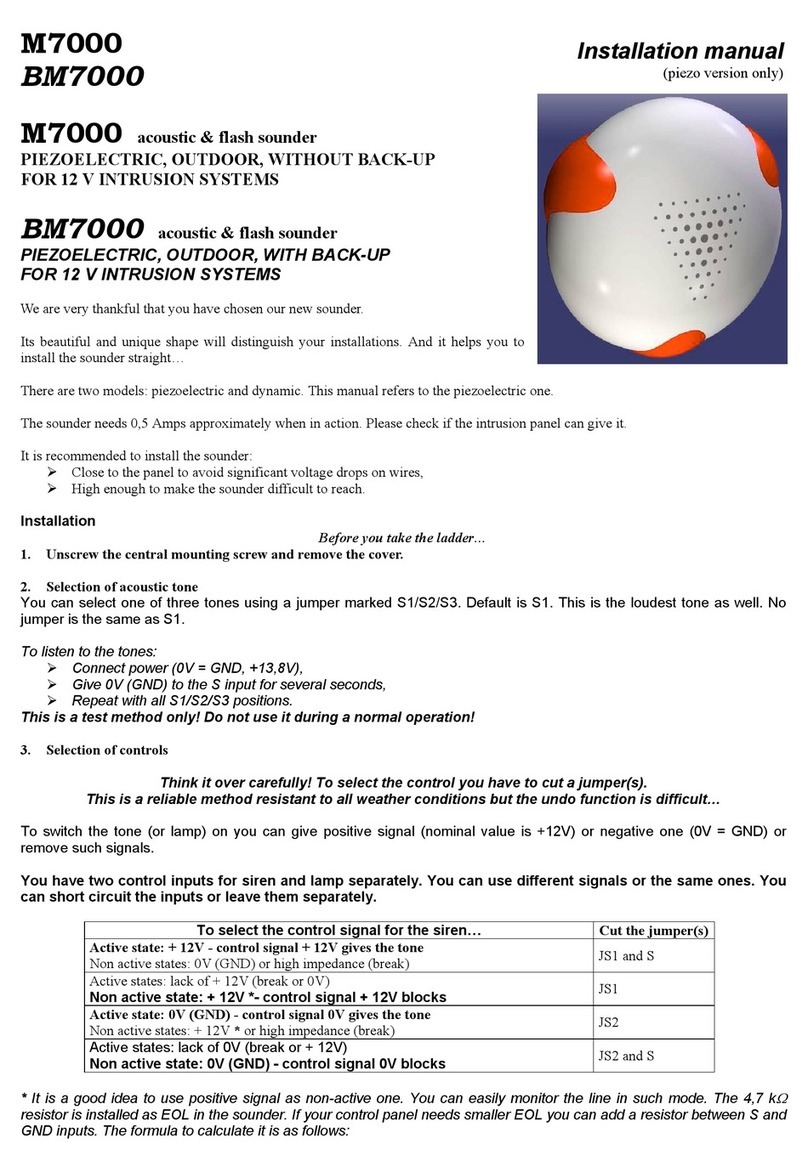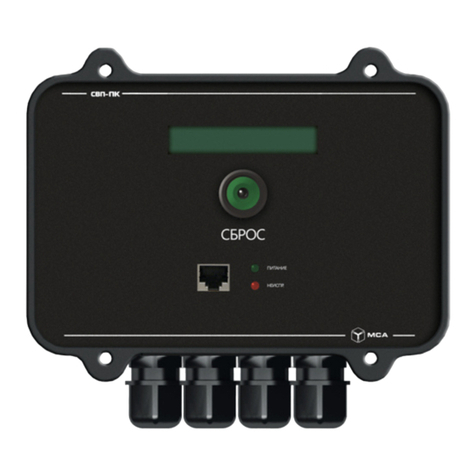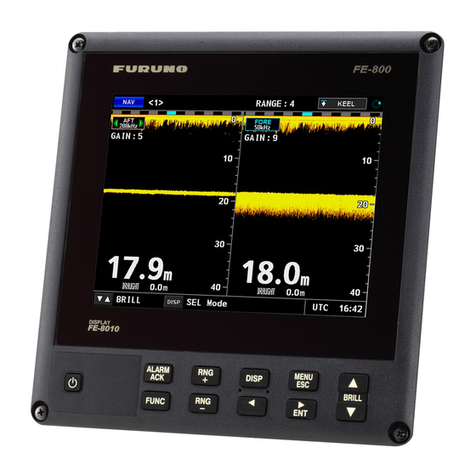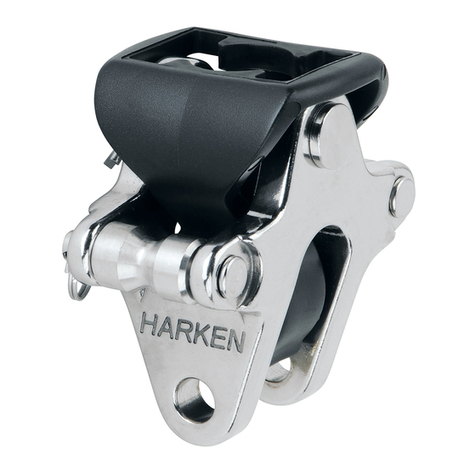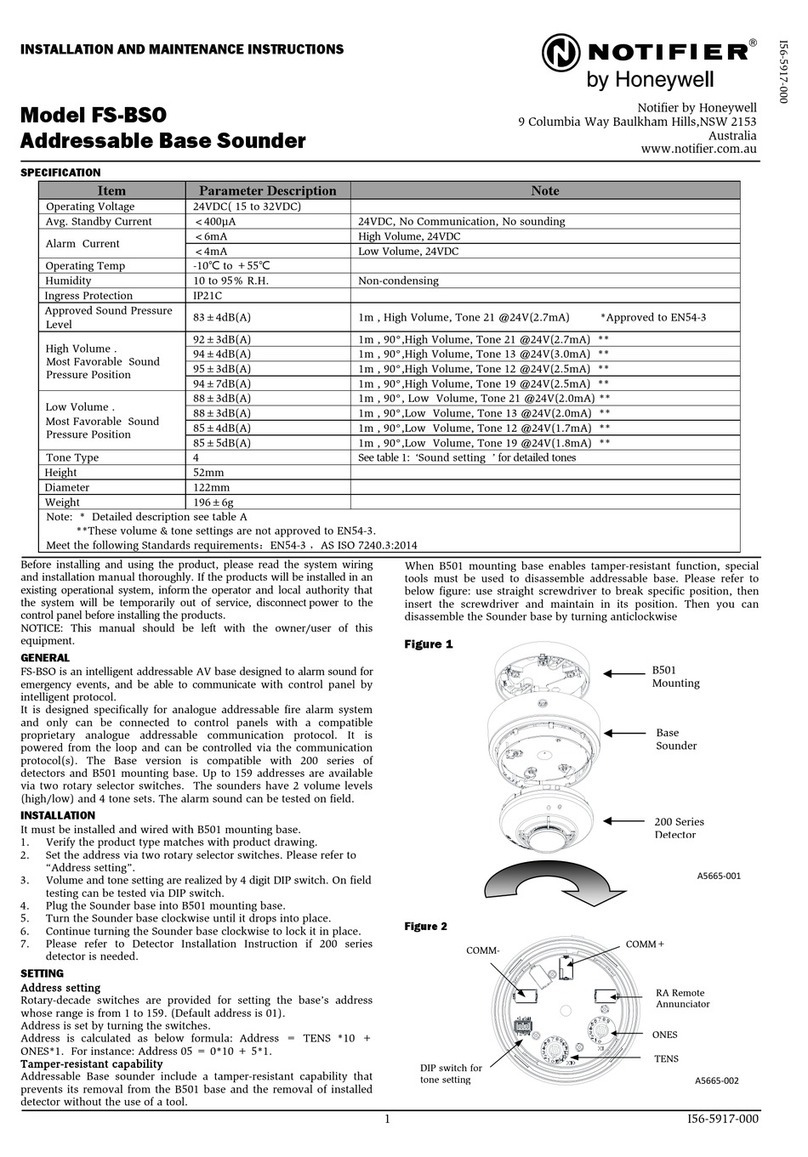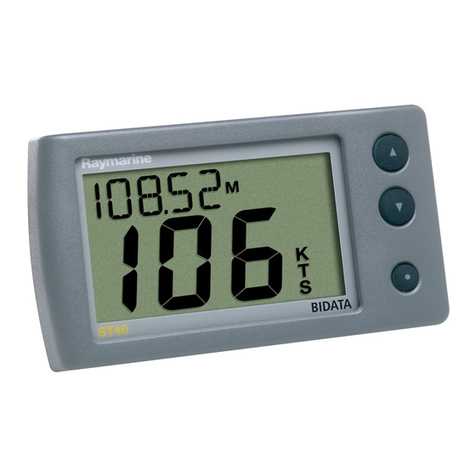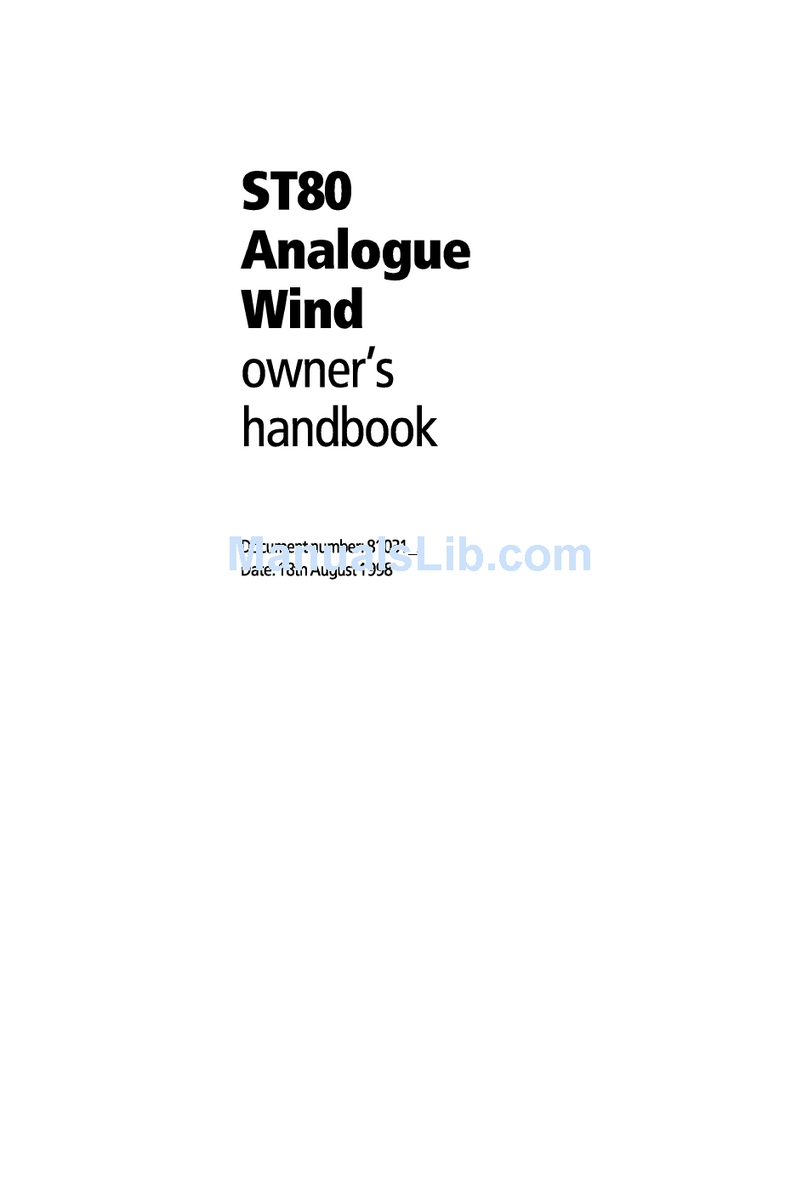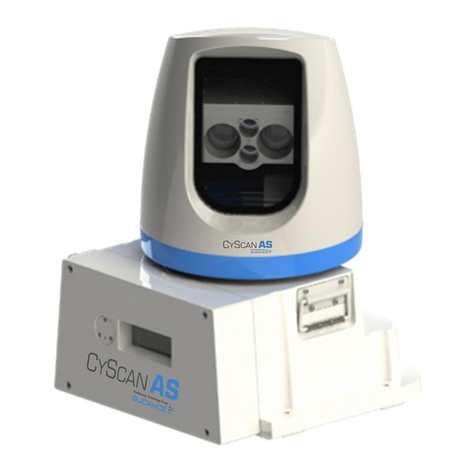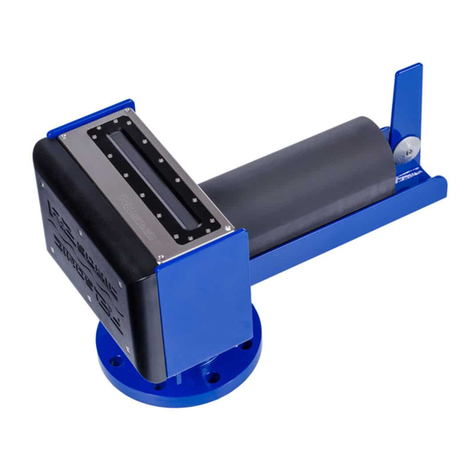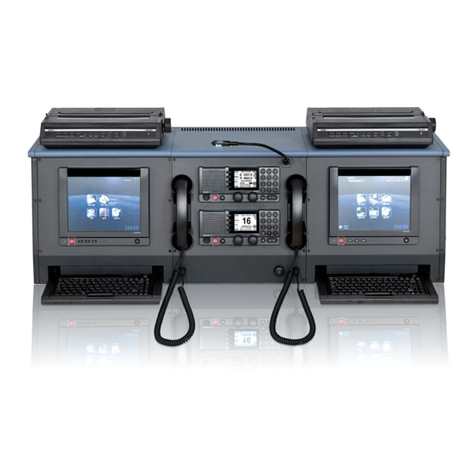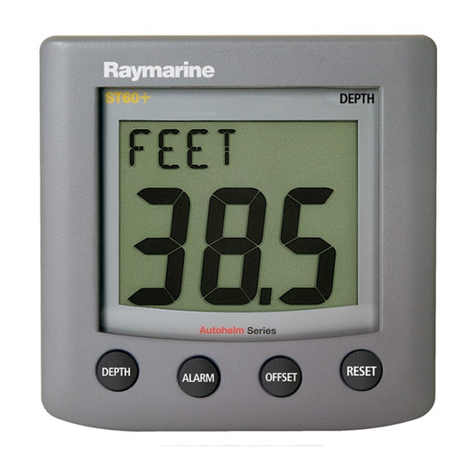Kohler 6EKOD User manual

Marine Generator Sets
Models:
6EKOD
5EFKOD
9--11EKOZD
7--9EFKOZD
TP-6774 2/14a
Service

TP-6774 2/14a2
Product Identification Information
Product identification numbers determine service parts.
Record the product identification numbers in the spaces
below immediately after unpacking the products so that
the numbers are readily available for future reference.
Record field-installed kit numbers after installing the
kits.
Generator Set Identification Numbers
Record the product identification numbers from the
generator set nameplate(s).
Model Designation
Specification Number
Serial Number
Accessory Number Accessory Description
Engine Identification
Record the product identification information from the
engine nameplate.
Manufacturer
Model Designation
Serial Number
x:in:007:001

TP-6774 2/14a Table of Contents 3
Table of Contents
Safety Precautions and Instructions 7.........................................................
Introduction 11...............................................................................
Service Assistance 11.........................................................................
Section 1 Specifications 13...................................................................
1.1 General 13..............................................................
1.2 Engine 14...............................................................
1.3 Generator, 4 Lead 15.....................................................
1.4 Generator, 12 Lead 15....................................................
1.5 Service Views 16.........................................................
1.6 Torque Specifications 17..................................................
Section 2 Scheduled Maintenance 19..........................................................
2.1 General 19..............................................................
2.2 Lubrication System 20....................................................
Section 3 Exhaust System 21..................................................................
3.1 Exhaust System Inspection 21.............................................
3.2 Servicing Mixing Elbow 21.................................................
Section 4 Fuel System 23.....................................................................
4.1 General 23..............................................................
4.2 Fuel Filter 23.............................................................
4.2.1 Fuel System Bleed 24.............................................
4.3 Fuel Pump 25............................................................
4.4 Governor 25.............................................................
4.5 Fuel Solenoid 25.........................................................
Section 5 Cooling System 27..................................................................
5.1 General 27..............................................................
5.2 Water-Cooled Exhaust Manifold 28.........................................
5.3 Coolant Replacement Including Heat Exchanger Service 28....................
5.4 Check and Fill Coolant 31.................................................
5.5 Flush and Clean Cooling System 32........................................
5.6 Pressure Cap 32.........................................................
5.7 Impeller Inspection and Replacement 32....................................
5.8 Belt Tension 33...........................................................
5.8.1 Seawater Pump Belt Tensioning Procedure 33.......................
5.9 Anticorrosion Zinc Anode 34...............................................
5.10 Siphon Break 35.........................................................
Section 6 Troubleshooting 37.................................................................
6.1 Introduction 37...........................................................
6.2 Initial Checks 37..........................................................
6.3 Troubleshooting Chart 37..................................................
Section 7 Controller 43.......................................................................
7.1 Introduction 43...........................................................
7.2 General Repair Information 44.............................................
7.3 SiteTechtSoftware 45....................................................
7.4 Controller Service Replacement Kit GM83745 45.............................
7.5 Advanced Digital Control IId Operation 47...................................
7.5.1 Controls and Indicators 47.........................................
7.5.2 Starting the Generator Set 48......................................
7.5.3 Stopping the Generator Set 49.....................................
7.5.4 Fault Shutdowns and Warnings 49..................................
7.5.5 Digital Display 51.................................................

TP-6774 2/14aTable of Contents4
7.5.6 Controller Fault Diagnostics 53.....................................
7.6 Communication Port 55...................................................
7.7 Fuses 55................................................................
7.8 Preheat Relay 55.........................................................
7.9 Battery Charging Module 56...............................................
7.10 Controller Logic Specifications 56...........................................
7.10.1 Fault Shutdown and Warning Specifications 56.......................
7.10.2 Controller Resetting (Following System Fault Shutdown) 60............
7.10.3 Voltage Regulator and Calibration Specifications 60...................
7.10.4 Voltage Regulator Adjustments 60..................................
7.10.5 System Fault Warning Lamp with Digital Displays 61..................
7.10.6 System Fault Shutdown Lamp With Digital Displays 62................
7.10.7 Status and Notice Digital Displays 63...............................
7.11 Menu Displays 64........................................................
7.12 Monitoring and Programming Setup 66......................................
7.12.1 PC Communications 66...........................................
7.13 Reviewing Menu Displays 66...............................................
7.13.1 Error Messages 66...............................................
7.13.2 Overview 67.....................................................
7.13.3 Engine Metering 67...............................................
7.13.4 Generator Metering (and Calibration) 68.............................
7.13.5 GenSet Information 69............................................
7.13.6 GenSet Run Time 69.............................................
7.13.7 GenSet System 69...............................................
7.13.8 Voltage Regulator 70..............................................
7.13.9 Event Log 70....................................................
7.13.10 Prime Menu 71...................................................
7.13.11 Volt Select 71....................................................
7.13.12 USB Flowchart 72................................................
Section 8 Component Testing and Adjustment 73...............................................
8.1 Theory of Operation 73....................................................
8.2 Separate Excitation 73....................................................
8.3 Exciter Field (9--11EKOZD/7--9EFKOZD Models) 75..........................
8.4 Exciter Armature (9--11EKOZD and 7--9EFKOZD Models) 76...................
8.5 Slip Rings (6EKOD/5EFKOD Models) 77....................................
8.6 Brushes (6EKOD/5EFKOD Models) 77......................................
8.7 Rectifier Module (9--11EKOZD and 7--9EFKOZD Models) 78...................
8.8 Rotor 78.................................................................
8.9 Stator 79................................................................
8.10 Voltage Regulator 81......................................................
8.10.1 Voltage Regulator and Calibration Specifications 81...................
8.10.2 Voltage Regulator Adjustments 81..................................
8.10.3 Voltage Regulator 82..............................................
8.11 Voltage Reconnection 83..................................................
8.12 Four-Lead Reconnection 85...............................................
8.12.1 100--120-Volt Configurations 85
....................................
8.12.2 100--120/200--240-Volt Configurations 85............................
8.12.3 200--240-Volt Configurations 86....................................
8.13 Twelve-Lead Reconnection 86.............................................
8.14 Fault Shutdown Tests 87..................................................
8.14.1 Controller Fault Shutdown Functions 87.............................
8.14.2 Fault Shutdown Senders/Switches 88...............................
8.15 Fuses 89................................................................
8.16 Continuity Checks 90.....................................................
Section 9 Generator Disassembly/Reassembly 91..............................................
9.1 Disassembly 91..........................................................
9.2 Collector Ring and Bearing Replacement (6EKOD/5EFKOD Model) 98..........
9.3 Reassembly 98..........................................................

TP-6774 2/14a Table of Contents 5
Section 10 Wiring Diagrams 101................................................................
10.1 Wiring Diagram Reference 101..............................................
10.2 Manual Marine (Ship-to-Shore) 2 Wire and 3 Wire Transfer Switches 107.........
10.3 Manual Marine (Ship-to-Shore) 4 Wire Transfer Switch 108.....................
Appendix A Abbreviations 109...................................................................
Appendix B Common Hardware Application Guidelines 111.........................................
Appendix C General Torque Specifications 112....................................................
Appendix D Common Hardware Identification 113..................................................
Appendix E Common Hardware List 114..........................................................

TP-6774 2/14aTable of Contents6
Notes

TP-6774 2/14a 7Safety Precautions and Instructions
Safety Precautions and Instructions
IMPORTANT SAFETY INSTRUCTIONS.
Electromechanical equipment,
including generator sets, transfer
switches, switchgear, and accessories,
can cause bodily harm and pose
life-threatening danger when
improperly installed, operated, or
maintained. To prevent accidents be
aware of potential dangers and act
safely. Read and follow all safety
precautions and instructions. SAVE
THESE INSTRUCTIONS.
This manual has several types of safety
precautions and instructions: Danger,
Warning, Caution, and Notice.
DANGER
Danger indicates the presence of a
hazard that will cause severe
personal injury, death,orsubstantial
property damage.
WARNING
Warning indicates the presence of a
hazard that can cause severe
personal injury, death, or substantial
property damage.
CAUTION
Caution indicates the presence of a
hazard that will or can cause minor
personal injury or property damage.
NOTICE
Notice communicates installation,
operation, or maintenance information
that is safety related but not hazard
related.
Safety decals affixed to the equipment
in prominent places alert the operator
or service technician to potential
hazards and explain how to act safely.
The decals are shown throughout this
publication to improve operator
recognition. Replace missing or
damaged decals.
Accidental Starting
Accidental starting.
Can cause severe injury or death.
Disconnect the battery cables before
working on the generator set.
Remove the negative (--) lead first
when disconnecting the battery.
Reconnect the negative (--) lead last
when reconnecting the battery.
WARNING
Disabling the generator set.
Accidental starting can cause
severe injury or death. Before
working on the generator set or
connected equipment, disable the
generator set as follows: (1) Move the
generator set master switch to the OFF
position. (2) Disconnect the power to
the battery charger. (3) Remove the
battery cables, negative (--) lead first.
Reconnect the negative (--) lead last
when reconnecting the battery. Follow
these precautions to prevent starting of
the generator set by an automatic
transfer switch, remote start/stop
switch, or engine start command from a
remote computer.
Engine Backfire/Flash
Fire
Fire.
Can cause severe injury or death.
Do not smoke or permit flames or
sparks near fuels or the fuel system.
WARNING
Servicing the fuel system. A flash
fire can cause severe injury or death.
Do not smoke or permit flames or
sparks near the fuel injection system,
fuel line, fuel filter, fuel pump, or other
potential sources of spilled fuels or fuel
vapors. Catch fuels in an approved
container when removing the fuel line
or fuel system.
Servicing the air cleaner. A sudden
backfire can cause severe injury or
death. Do not operate the generator
set with the air cleaner/silencer
removed.
Combustible materials. A sudden
flash fire can cause severe injury or
death. Do not smoke or permit flames
or sparks near the generator set. Keep
the compartment and the generator set
clean and free of debris to minimize the
risk of fire. Catch fuels in an approved
container. Wipe up spilled fuels and
engine oil.
Combustible materials. A fire can
cause severe injury or death.
Generator set engine fuels and fuel
vapors are flammable and explosive.
Handle these materials carefully to
minimize the risk of fire or explosion.
Equip the compartment or nearby area
with a fully charged fire extinguisher.
Select a fire extinguisher rated ABC or
BC for electrical fires or as
recommended by the local fire code or
an authorized agency. Train all
personnel on fire extinguisher
operation and fire prevention
procedures.
Exhaust System
Carbon monoxide.
Can cause severe nausea,
fainting, or death.
The exhaust system must be
leakproof and routinely inspected.
WARNING

TP-6774 2/14a8 Safety Precautions and Instructions
Carbon monoxide symptoms.
Carbon monoxide can cause severe
nausea, fainting, or death. Carbon
monoxide is a poisonous gas present in
exhaust gases. Carbon monoxide is an
odorless, colorless, tasteless,
nonirritating gas that can cause death if
inhaled for even a short time. Carbon
monoxide poisoning symptoms include
but are not limited to the following:
DLight-headedness, dizziness
DPhysical fatigue, weakness in
joints and muscles
DSleepiness, mental fatigue,
inability to concentrate
or speak clearly, blurred vision
DStomachache, vomiting, nausea
If experiencing any of these symptoms
and carbon monoxide poisoning is
possible, seek fresh air immediately
and remain active. Do not sit, lie down,
or fall asleep. Alert others to the
possibility of carbon monoxide
poisoning. Seek medical attention if
the condition of affected persons does
not improve within minutes of breathing
fresh air.
Inspecting the exhaust system.
Carbon monoxide can cause severe
nausea, fainting, or death. For the
safety of the craft’s occupants, install a
carbon monoxide detector. Never
operate the generator set without a
functioning carbon monoxide detector.
Inspect the detector before each
generator set use.
Operating the generator set. Carbon
monoxide can cause severe nausea,
fainting, or death. Be especially
careful if operating the generator set
when moored or anchored under calm
conditions because gases may
accumulate. If operating the generator
set dockside, moor the craft so that the
exhaust discharges on the lee side (the
side sheltered from the wind). Always
be aware of others, making sure your
exhaust is directed away from other
boats and buildings.
Fuel System
Explosive fuel vapors.
Can cause severe injury or death.
Use extreme care when handling,
storing, and using fuels.
WARNING
The fuel system. Explosive fuel
vapors can cause severe injury or
death. Vaporized fuels are highly
explosive. Use extreme care when
handling and storing fuels. Store fuels
in a well-ventilated area away from
spark-producing equipment and out of
the reach of children. Never add fuel to
the tank while the engine is running
because spilled fuel may ignite on
contact with hot parts or from sparks.
Do not smoke or permit flames or
sparks to occur near sources of spilled
fuel or fuel vapors. Keep the fuel lines
and connections tight and in good
condition. Do not replace flexible fuel
lines with rigid lines. Use flexible
sections to avoid fuel line breakage
caused by vibration. Do not operate the
generator set in the presence of fuel
leaks, fuel accumulation, or sparks.
Repair fuel systems before resuming
generator set operation.
Draining the fuel system. Explosive
fuel vapors can cause severe injury
or death. Spilled fuel can cause an
explosion. Use a container to catch fuel
when draining the fuel system. Wipe up
spilled fuel after draining the system.
Hazardous Noise
Hazardous noise.
Can cause hearing loss.
Never operate the generator set
without a muffler or with a faulty
exhaust system.
CAUTION
Hazardous Voltage/
Moving Parts
Hazardous voltage.
Can cause severe injury or death.
Operate the generator set only when
all guards and electrical enclosures
areinplace.
Moving parts.
WARNING
Servicing the generator set when it
is operating. Exposed moving parts
can cause severe injury or death.
Keep hands, feet, hair, clothing, and
test leads away from the belts and
pulleys when the generator set is
running. Replace guards, screens, and
covers before operating the generator
set.
Grounding electrical equipment.
Hazardous voltage can cause
severe injury or death. Electrocution
is possible whenever electricity is
present. Ensure you comply with all
applicable codes and standards.
Electrically ground the generator set,
transfer switch, and related equipment
and electrical circuits. Turn off the main
circuit breakers of all power sources
before servicing the equipment. Never
contact electrical leads or appliances
when standing in water or on wet
ground because these conditions
increase the risk of electrocution.
Disconnecting the electrical load.
Hazardous voltage can cause
severe injury or death. Disconnect
the generator set from the load by
turning off the line circuit breaker or by
disconnecting the generator set output
leads from the transfer switch and
heavily taping the ends of the leads.
High voltage transferred to the load
during testing may cause personal
injury and equipment damage. Do not
use the safeguard circuit breaker in
place of the line circuit breaker. The
safeguard circuit breaker does not
disconnect the generator set from the
load.

TP-6774 2/14a 9Safety Precautions and Instructions
Short circuits. Hazardous
voltage/current can cause severe
injury or death. Short circuits can
cause bodily injury and/or equipment
damage.Do not contact electrical
connections with tools or jewelry while
making adjustments or repairs.
Remove all jewelry before servicing the
equipment.
Electrical backfeed to the utility.
Hazardous backfeed voltage can
cause severe injury or death.
Connect the generator set to the
building/marina electrical system only
through an approved device and after
the building/marina main switch is
turned off. Backfeed connections can
cause severe injury or death to utility
personnel working on power lines
and/or personnel near the work area.
Some states and localities prohibit
unauthorized connection to the utility
electrical system. Install a
ship-to-shore transfer switch to prevent
interconnection of the generator set
power and shore power.
Testing live electrical circuits.
Hazardous voltage or current can
cause severe injury or death. Have
trained and qualified personnel take
diagnostic measurements of live
circuits. Use adequately rated test
equipment with electrically insulated
probes and follow the instructions of the
test equipment manufacturer when
performing voltage tests. Observe the
following precautions when performing
voltage tests: (1) Remove all jewelry.
(2) Stand on a dry, approved electrically
insulated mat. (3) Do not touch the
enclosure or components inside the
enclosure. (4) Be prepared for the
system to operate automatically.
(600 volts and under)
Hot Parts
Hot coolant and steam.
Can cause severe injury or death.
Before removing the pressure cap,
stop the generator set and allow it to
cool. Then loosen the pressure cap
to relieve pressure.
WARNING
Notice
NOTICE
Fuse replacement. Replace fuses
with fuses of the same ampere rating
and type (for example: 3AB or 314,
ceramic). Do not substitute clear
glass-type fuses for ceramic fuses.
Refer to the wiring diagram when the
ampere rating is unknown or
questionable.
NOTICE
Saltwater damage. Saltwater quickly
deteriorates metals. Wipe up saltwater
on and around the generator set and
remove salt deposits from metal
surfaces.

TP-6774 2/14a10 Safety Precautions and Instructions
Notes

TP-6774 2/14a 11Introduction
Introduction
This manual provides troubleshooting and repair
instructions for 6EKOD, 9-11EKOZD, 5EFKOD and
7-9EFKOZD model generator sets (4-lead and
12-lead), Advanced Digital Control, and accessories.
Refer to the engine service manual for generator set
engine service information.
x:in:001:001
Information in this publication represents data available
at the time of print. Kohler Co. reserves the right to
change this publication and the products represented
without notice and without any obligation or liability
whatsoever.
Read this manual and carefully follow all procedures
and safety precautions to ensure proper equipment
operation and to avoid bodily injury. Read and follow the
Safety Precautions and Instructions section at the
beginning of this manual. Keep this manual with the
equipment for future reference.
The equipment service requirements are very important
to safe and efficient operation. Inspect the parts often
and perform required service at the prescribed intervals.
Maintenance work must be performed by appropriately
skilled and suitably-trained maintenance personnel
familiar with generator set operation and service.
x:in:001:003
Service Assistance
For professional advice on generator set power
requirements and conscientious service, please contact
your nearest Kohler distributor or dealer.
DConsult the Yellow Pages under the heading
Generators—Electric
DVisit the Kohler Power Systems website at
KOHLERPower.com.
DLook at the labels and stickers on your Kohler product
or review the appropriate literature or documents
included with the product
DCall toll free in the US and Canada 1-800-544-2444
DOutside the US and Canada, call the nearest regional
office
Headquarters Europe, Middle East,Africa
(EMEA)
Kohler Power Systems Netherlands B.V.
Kristallaan 1
4761 ZC Zevenbergen
The Netherlands
Phone: (31) 168 331630
Fax: (31) 168 331631
Asia Pacific
Power Systems Asia Pacific Regional Office
Singapore, Republic of Singapore
Phone: (65) 6264-6422
Fax: (65) 6264-6455
China
North China Regional Office, Beijing
Phone: (86) 10 6518 7950
(86) 10 6518 7951
(86) 10 6518 7952
Fax: (86) 10 6518 7955
East China Regional Office, Shanghai
Phone: (86) 21 6288 0500
Fax: (86) 21 6288 0550
India, Bangladesh, Sri Lanka
India Regional Office
Bangalore, India
Phone: (91) 80 3366208
(91) 80 3366231
Fax: (91) 80 3315972
Japan, Korea
North Asia Regional Office
Tokyo, Japan
Phone: (813) 3440-4515
Fax: (813) 3440-2727
Latin America
Latin America Regional Office
Lakeland, Florida, USA
Phone: (863) 619-7568
Fax: (863) 701-7131

TP-6774 2/14a12 Service Assistance
Notes

TP-6774 2/14a 13Section 1 Specifications
Section 1 Specifications
1.1 General
This manual covers maintenance, troubleshooting, and
repair of the alternating current marine generator sets
listed in Figure 1-1. Consult the generator set nameplate
for specific generator set ratings.
Models Voltage Hz Ph
6EKOD 120
120/240 60 1
9/11EKOZD 120
120/240 60 1
11EKOZD
220/380
240/416
120/240
127/220
60 3
5EFKOD
115/230
230
240
50 1
7/9EFKOZD
115/230
230
240
50 1
9EFKOZD 230/400 50 3
Figure 1-1 Generator Model Coverage
The 6EKOD/5EFKOD (single-phase) models are
powered by a three-cylinder, water-cooled, four-cycle
diesel engine with a heat exchanger.
The 9EKOZD/7EFKOZD (single-phase) models are
powered by a three-cylinder, water-cooled, four-cycle
diesel engine with a heat exchanger.
The 11EKOZD/9EFKOZD (single- and three-phase)
models are powered by a four-cylinder, water-cooled,
four-cycle diesel engine with a heat exchanger.
Heat exchanger cooling consists of a heat exchanger
with a coolant recovery tank, thermostat, rubber
impeller seawater pump, centrifugal type engine
circulating pump, water-cooled exhaust manifold, and
an exhaust mixer.
Kohler Co. develops all Kohlerrmarine generator set
ratings using accepted reference conditions of 25_C
(77_F) and pressure of 29.2 in. Hg dry barometer.
ISO 3046 and ISO 8528-1 include reference conditions
and output calculations. Obtain the technical
information bulletin on ratings guidelines (TIB-101) for
complete ratings definitions.
Read this manual, then carefully follow all service
recommendations. See Figure 1-2 for identification and
location of components.

TP-6774 2/14a14 Section 1 Specifications
1.2 Engine
Generator Model
6EKOD/
5EFKOD
(1 Phase)
9EKOZD/
7EFKOZD
(1 Phase)
11EKOZD/
9EFKOZD
(1 Phase)
11EKOZD/
9EFKOZD
(3 Phase)
Number of cylinders 3 4
Type 4 cycle, naturally aspirated
Engine block material Cast iron with re-borable integral liners
Cylinder head material Aluminum
Governor Centrifugal, mechanical
Engine firing order (#1 cylinder on
flywheel end or alternator end) 1--3--2 1--3--4-2
Direction of rotation (as viewed from
flywheel) Counterclockwise
Combustion system Indirect injection
Bore x stroke, mm (in.) 75 x 77.6 (2.95 x 3.05)
Displacement L (CID) 1.028 (62.7) 1.372 (83.7)
Compression ratio 24.5:1
Max. power at rated rpm, HP 60/50 Hz 10.1/8.4 14.5/11.9 19.6/15.4
RPM 60/50 Hz 1800/1500
Lubrication system Pressurized oil system with oil pump
Lube oil capacity, w/filter L (U.S. qts.) 2.5 (2.6) 3.4 (3.6)
Oil recommendation (API) CD or CF class
Fuel recommendation (API) Cetane No. 51 min. Fuel with low sulphur content: API CF4, CG4 or
Fuel with high sulphur content API CF, CD, CE
Fuel shutoff solenoid Electric
Fuel pump Electric
Max. recommended fuel pump lift, m (ft.) 0.9 (3) 1.2 (4)
Battery voltage 12 volts
Battery charging module 10-amp
Battery recommendation (minimum) 650 CCA @ 0_F
Starter motor 2.5 kW, 12 volt
Recommended coolant 50% ethylene glycol; 50% clean, softened water
Coolant capacity, approx. L (U.S. qts.)
add 0.24 L (8 oz.) for coolant recovery tank 3 (3.2) 4.3 (4.5)
Thermostat, opening temp. _C(_F) 83--87 (181--188)
High exhaust temperature shutdown,
_C(_F) 102±2.8 (215±5)
Seawater inlet water line hose ID, mm (in.) 19 (0.75) with or without sound shield
Water cooled exhaust outlet hose ID,
mm (in.) 51 (2) with or without sound shield
Fuel inlet size 1/4 NPT with or without sound shield
Fuel return size 1/4 NPT with or without sound shield
Fuel injection pressure, bar 128--137
Intake/exhaust valve clearance (cold),
mm (in.) 0.20 (0.008)
Fuel pump static pressure, psi 4--8 (12-volt pump)
Pressure cap’s overpressure valve
opening pressure, bar 0.7

TP-6774 2/14a 15Section 1 Specifications
1.3 Generator, 4 Lead
Component Specification
6EKOD
5EFKOD
Main field (rotor) resistance (cold)—ohms @ 20_C(68_F) 4.4--5.0
Stator output voltages with separately excited generator, using 12-volt battery (60 Hz only)
1--2, 3--4—volts 130
55--66—volts 155
Cold stator resistance
1--2, 3--4—ohms 0.19
55--66—ohms 2.7
Component Specification
9EKOZD/
7EFKOZD
11EKOZD/
9EFKOZD
Hot exciter field voltage/amperage readings at rated voltage
No load (63 Hz)—volts/amps 12/0.8 5/0.9
Full load (60 Hz)—volts/amps 33/2.2 14/2.3
Exciter field resistance (cold)—ohms @ 20_C(68_F) 4.8 4.8
Exciter armature resistance (cold)—ohms (line-to-line) 1.18 1.18
Main field (rotor) resistance (cold)—ohms @ 20_C(68_F) 5.7 5.7
Stator output voltages with separately excited generator, using 12-volt battery (60 Hz only)
1--2, 3--4—volts 115 184
55--66—volts 155 193
Cold stator resistance
1--2, 3--4—ohms 0.19 0.28
55--66—ohms 1.9 1.3
1.4 Generator, 12 Lead
Component Specification
11EKOZD/
9EFKOZD
Hot exciter field voltage/amperage readings at rated voltage
No load (63 Hz)—volts/amps 7/1.3
Full load (60 Hz)—volts/amps 20/3.3
Exciter field resistance (cold)—ohms @ 20_C(68_F) 4.8
Exciter armature resistance (cold)—ohms (line-to-line) 1.18
Main field (rotor) resistance (cold)—ohms @ 20_C(68_F) 5.7
Stator output voltages with separately excited generator, using 12-volt battery (60 Hz only)
1--4, 2--5, 3--6, 7--10, 8--11, 9--12—volts 160
55--66—volts 192
Cold stator resistance
1--4, 2--5, 3--6, 7--10, 8--11, 9--12—ohms 0.34
55--66—ohms 0.88

TP-6774 2/14a16 Section 1 Specifications
1.5 Service Views
1. Battery charging module
2. ADC IId controller
3. USB port
4. Nameplate (on top of controller)
5. Fuses (F1, F2, and F3)
6. AC circuit breaker panel
7. Closed breather
8. Battery positive (+) connection
9. Seawater pressure switch
10. Coolant fill/coolant overflow tube
11. Seawater inlet
12. Fuel solenoid
13. Fuel filter
14. Seawater pump
15. Oil check/dipstick
16. Fuel return
17. Coolant overflow bottle
18. Oil drain valve
19. Oil fill
20. Fuel feed pump
21. Fuel inlet
22. Oil filter
23. Customer load lead connection
24. Alternator cooling air inlet
25. V-belt
26. Belt guard
27. Battery negative (--) connection
28. Seawater drain
29. Engine coolant drain
30. Coolant temperature sensor
31. Thermostat assembly
32. Heat exchanger internal to exhaust manifold
33. Lifting eye
34. Oil pressure sender
35. High exhaust temperature switch
36. Mixing elbow (water outlet/exhaust outlet)
37. Customer interface
38. Anticorrosion zinc anode
39. Air outlet
28
15
17 2618
16
37
2520 19
11
27
10
14
13
6
21
45
36
33
3
23 22
39
Non Service-Side View
ADV7942-A
24
32
28
38
12
7
35
9
34
30 31
29
1
Figure 1-2 Service Views—Typical

TP-6774 2/14a 17Section 1 Specifications
1.6 Torque Specifications
Follow the general torque specification found in
Appendix C of this manual unless noted below.
Generator Model
6EKOD/
5EFKOD
(1 Phase)
Overbolts 23 Nm (17 ft. lbs.)
Drive discs to rotor hub 45 Nm (34 ft. lbs.)
Rotor fan to flywheel 23 Nm (17 ft. lbs.)
Back plate to engine block 23 Nm (17 ft. lbs.)
Locator plate to engine block 23 Nm (17 ft. lbs.)
Flywheel mounting bolts 80 Nm (59 ft. lbs.)
Brush holder to brush holder brack-
et 4 Nm (35 in. lbs.)
Brush bracket to end bracket 6.5 Nm (50 in. lbs.)
Thermostat housing 23 Nm (17 in. lbs.)
Exhaust manifold 25 Nm (18 in. lbs.)
Cylinder head
Follow the numerical order shown in the
diagram and tighten the bolts in 3 phases:
1st phase: 50 Nm (37 ft. lbs.)
2nd phase: Rotate the wrench clockwise 90_
3rd phase: Rotate the wrench again clockwise 90_
Generator Model
9EKOZD/
7EFKOZD
(1 Phase)
11EKOZD/
9EFKOZD
(1 Phase)
11EKOZD/
9EFKOZD
(3 Phase)
Overbolts 23 Nm (17 ft. lbs.)
Drive discs to rotor hub 45 Nm (34 ft. lbs.)
Rotor fan to flywheel 23 Nm (17 ft. lbs.)
Back plate to engine block 23 Nm (17 ft. lbs.)
Locator plate to engine block 23 Nm (17 ft. lbs.)
Flywheel mounting bolts 80 Nm (59 ft. lbs.)
Exciter armature to rotor shaft 38 Nm (28 ft. lbs.)
Thermostat housing 23 Nm (17 ft. lbs.)
Exhaust manifold 25 Nm (18 ft. lbs.)
Cylinder head
Follow the numerical order shown in the
diagram and tighten the bolts in 3 phases:
1st phase: 50 Nm (37 ft. lbs.)
2nd phase: Rotate the wrench clockwise 90_
3rd phase: Rotate the wrench again clockwise 90_

TP-6774 2/14a18 Section 1 Specifications
Notes

TP-6774 2/14a 19Section 2 Scheduled Maintenance
Section 2 Scheduled Maintenance
2.1 General
Schedule routine maintenance using the service
schedule located in the generator set operation manual
and the runtime hours shown on the ADC IId. If the
generator set will be subject to extreme operating
conditions, service the unit accordingly.
Note: See the generator set operation manual for the
service schedule and other service not included
in this manual.
Note: High-mineral content seawater (salt water) can
cause rapid destruction of metals. Wipe up all
salt water spillage on and around the generator
set and keep metal surfaces free from
accumulated salt deposits.
Accidental starting.
Can cause severe injury or death.
Disconnect the battery cables before
working on the generator set.
Remove the negative (--) lead first
when disconnecting the battery.
Reconnect the negative (--) lead last
when reconnecting the battery.
WARNING
Disabling the generator set. Accidental starting can
cause severe injury or death. Before working on the
generator set or connected equipment, disable the generator
set as follows: (1) Move the generator set master switch to the
OFF position. (2) Disconnect the power to the battery charger.
(3) Remove the battery cables, negative (--) lead first.
Reconnect the negative (--) lead last when reconnecting the
battery. Follow these precautions to prevent starting of the
generator set by an automatic transfer switch, remote
start/stop switch, or engine start command from a remote
computer.
Hazardous voltage.
Can cause severe injury or death.
Operate the generator set only when
all guards and electrical enclosures
areinplace.
Moving parts.
WARNING
Servicing the generator set when it is operating. Exposed
moving parts can cause severe injury or death. Keep
hands, feet, hair, clothing, and test leads away from the belts
and pulleys when the generator set is running. Replace
guards, screens, and covers before operating the generator
set.

TP-6774 2/14a20 Section 2 Scheduled Maintenance
2.2 Lubrication System
Use oil that meets the American Petroleum Institute
(API) classification of CD or CF. Using an unsuitable oil
or neglecting an oil change may result in damage and a
shorter engine life. Figure 2-1 shows the recommended
Society of Automotive Engineers (SAE) viscosity
designation for given operating temperature ranges.
1234567890
SAE 20W*
SAE 30*
SAE 40*
SAE 10W--30**
SAE 10W--40**
SAE 10W--60**
SAE 15W--40 **
SAE 5W--30 ***
SAE 0W--30 ***
SAE 10W*
SAE 5W--40 ***
* Mineral base
** Semi--synthetic base
*** Synthetic base
SAE-- Grade
SAE 15W--40 **
SAE 20W--60 **
--
40
--
35
--
30
--
25
--
20
--
15
--
10
--
50
+
5
+
10
+
15
+
20
+
25
+
30
+
35
+
40
+
45
+
50
Figure 2-1 Engine Oil Selection
Note: Failure to observe the oil specifications may
cause inadequate lubrication/oil pressure and
cold-starting difficulties.
Other manuals for 6EKOD
4
This manual suits for next models
3
Table of contents
Other Kohler Marine Equipment manuals

Kohler
Kohler 5EOZ User manual
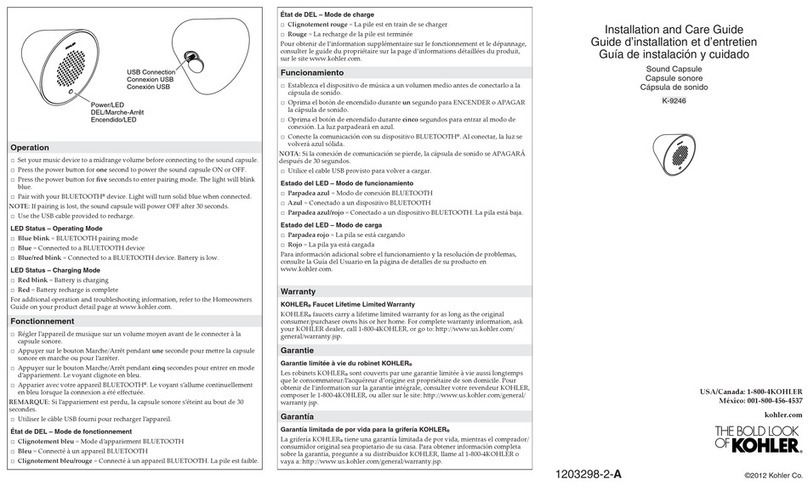
Kohler
Kohler K-9246 Assembly instructions
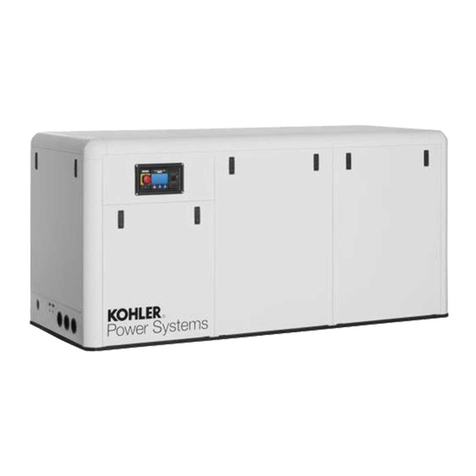
Kohler
Kohler GM89754-KP2 User manual
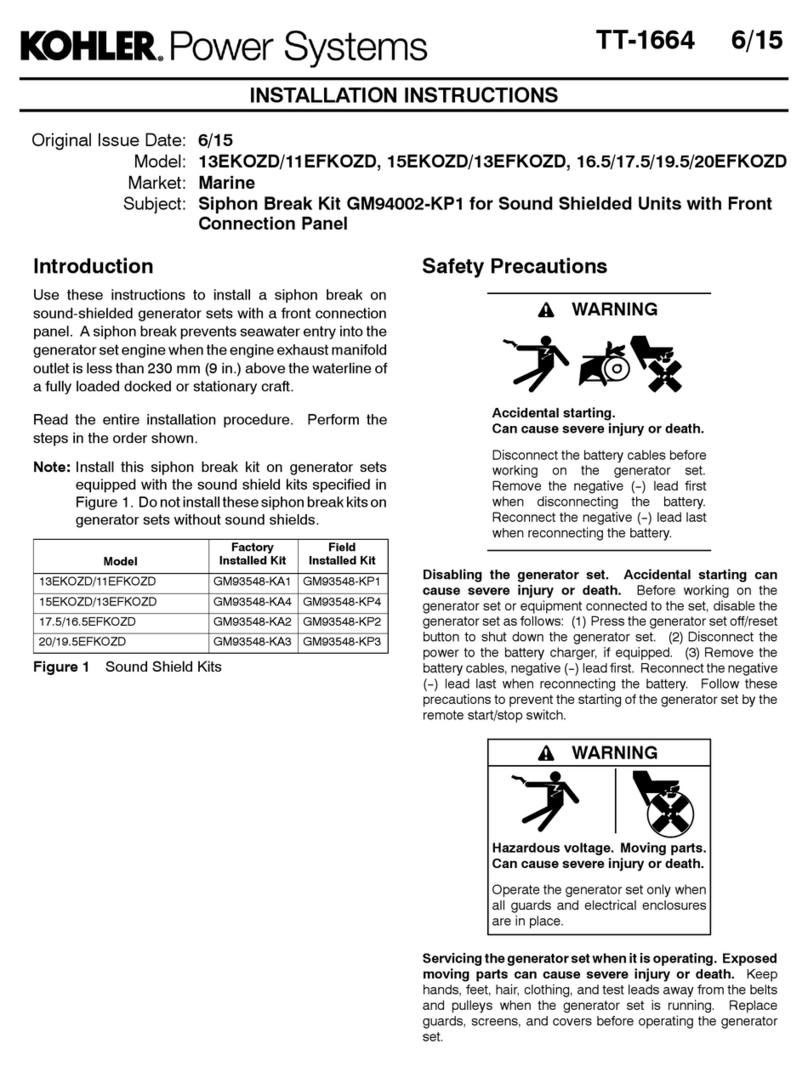
Kohler
Kohler 13EKOZD User manual
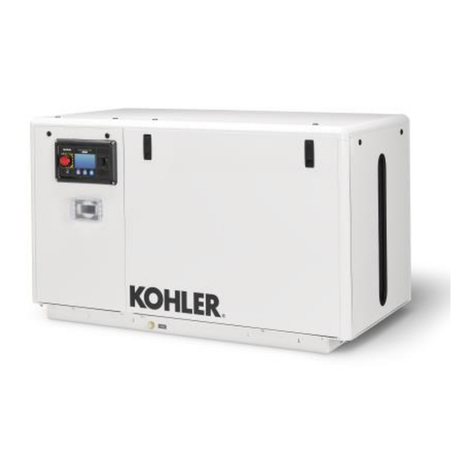
Kohler
Kohler 40EFOZDJ User manual

Kohler
Kohler 150EOZDJ User manual
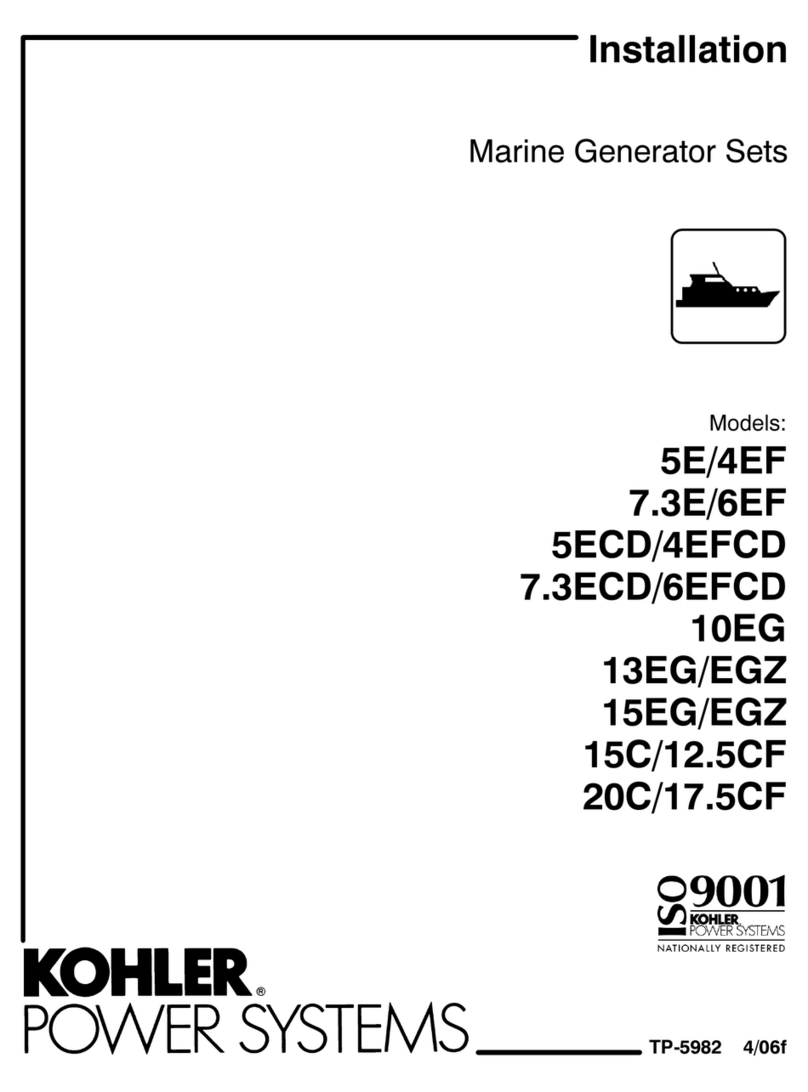
Kohler
Kohler 5E/4EF User manual
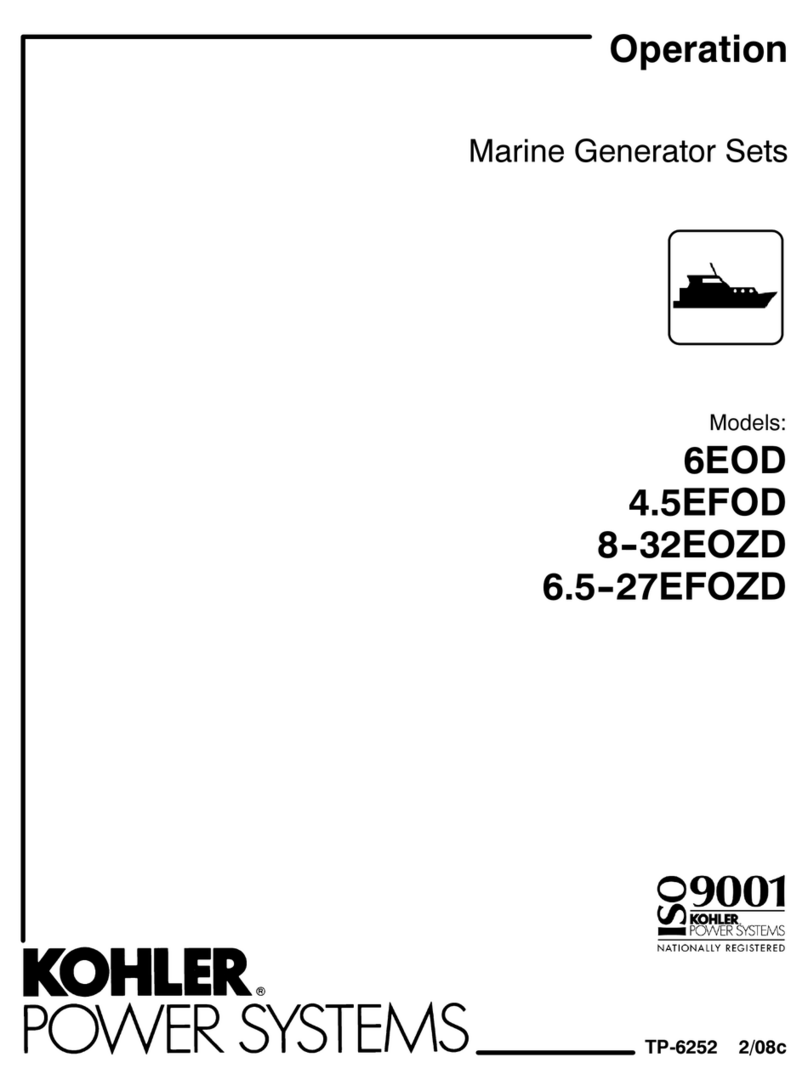
Kohler
Kohler 6EOD Instruction Manual
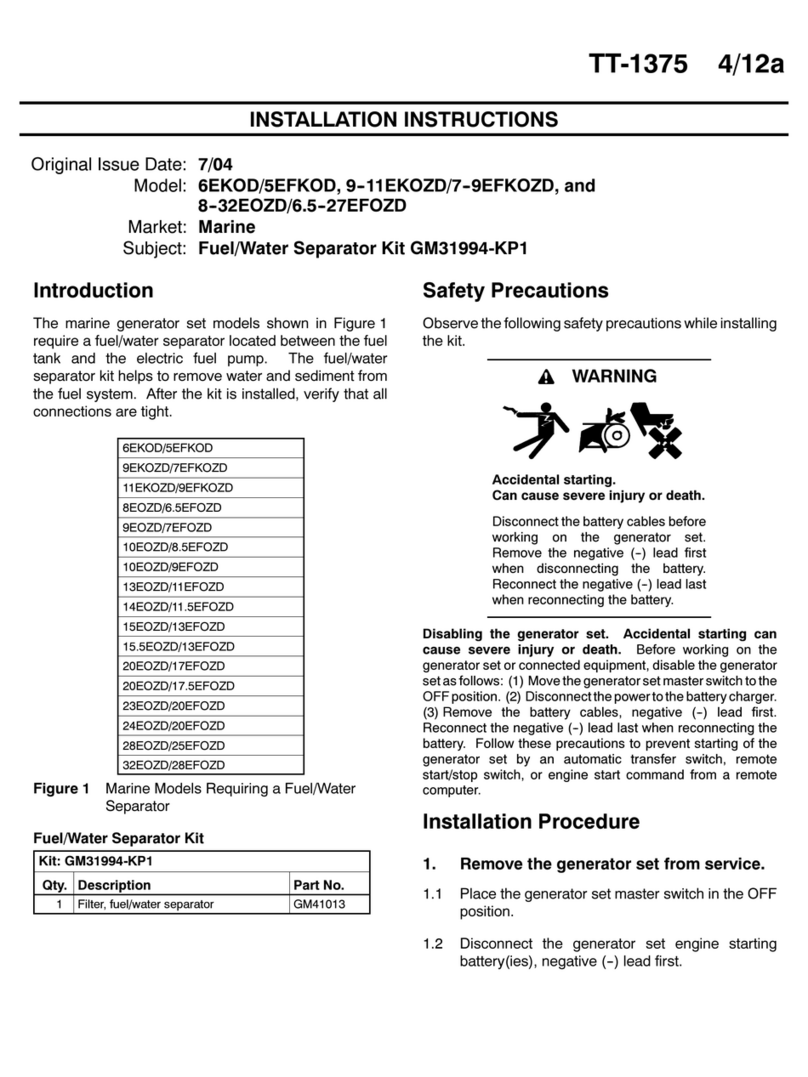
Kohler
Kohler GM31994-KP1 User manual
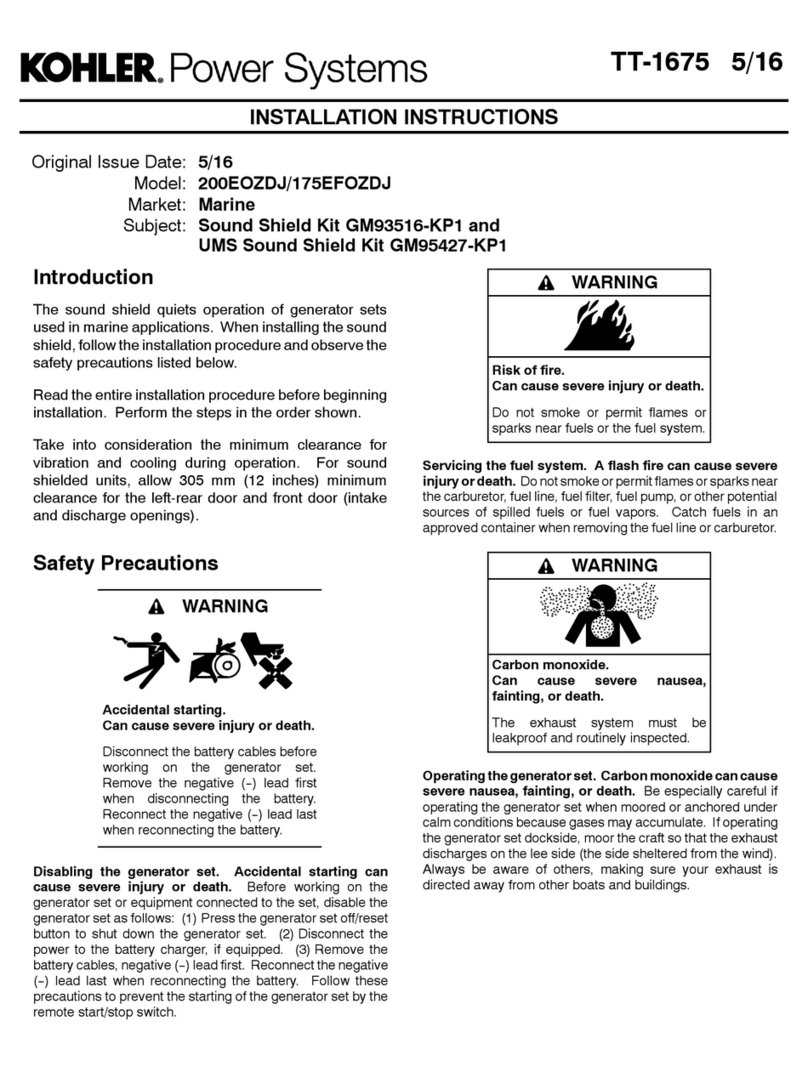
Kohler
Kohler GM93516-KP1 User manual

